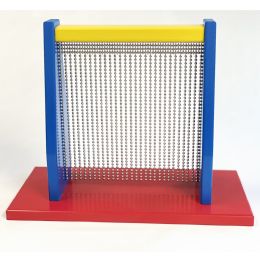Pediatric tactile stimulation toys encourage function along with fun to engage children of all ages and abilities. These toys offer various textures to help children learn to tolerate items with different surfaces, as well as rewarding them with personal accomplishment in overcoming their fears.
Rehabmart is pleased to carry a wide variety of innovative pediatric tactile stimulation toys for children of all abilities from high quality vendors, which include Experia-USA, SportsPlay Equipment, TFH, Sammons Preston, Maddak, Adaptivation, and Southpaw Enterprises.

.jpg&newheight=260&quality=80)
What is Pediatric Tactile Stimulation?
Tactile stimulation involves sensations of the touch and texture of everything around a child. A child with tactile sensory issues may have difficulty tolerating the sensations generated when getting dressed, being groomed, eating, or playing with toys. To help a child overcome this sensitivity to touch and texture, various types of toys and activities can assist the child in learning to tolerate these various sensations, such as brushes, balls, tables, vibrating toys, blankets, fiber optic toys, activity centers, gel trays, textured walls, water toys and sand toys.
How Do I Choose the Best Pediatric Tactile Stimulation Toys?
When choosing toys for a child with special needs, keep the child’s interests in mind. The toys should be fun and capture the attention to help a child develop and grow. The toys should also be played with repeatedly in order to experience all of their benefits.
A stimulation toy that aligns with a child’s specific interest is an important aspect of making the correct choice. If the child has a strong interest for outer space, dolls, bright lights, moving objects or music, choose toys with those similar themes. Exciting and fun toys will be more engaging for children, engendering the best chance that they will play with them repeatedly and have therapeutic success with them.
Matching a child’s developmental age with stimulation toys is another consideration. Developmental age is determined by the child’s degree of mental, social and physiological maturation, which is different than chronological age. Instead of choosing toys based on age, it is important to make selections based on the child’s skill level. For example, a ten year old working on fine motor skills may be successful with an activity center originally intended for a preschool-aged child.
Another consideration for tactile toys is to appeal to a child’s particular sensory needs. Tactile toys with multisensory components can help a child to interpret, process and regulate sensory information better, such as auditory, tactile, and visual components. To aid in sensory processing, choose toys with buzzers, lights, music, scents, and various textures. Since every child is unique, toys which are not stimulating enough for one child may be overly stimulating for another child.
Stimulation toys that provide a challenge for the child is another important point to consider when deciding on the right toy. However, the toy should also offer opportunities for the child’s success. Choosing games, toys or workbooks with many skill levels or multiple ways to play can help children “graduate” to something more challenging as they improve.
Choosing toys which encourage inclusive play is also helpful. These types of toys are the same toys the child’s siblings and friends would play with, and can help with group play and social interaction. For example, games encourage cooperative play, and sand and water tables make it fun for kids with special needs to play outside with friends and family.
Stimulation toys that are open-ended and adaptable offer more opportunities for a child’s success. Adaptable toys inspire repeated play sessions, and open-ended toys encourage self-expression and creativity. Consider adapting play foam or putty by using it to practice forming the letters of the alphabet, or adapting a craft kit by using its contents for a counting or matching game.
Toys and activities which involve the fine motor skills of a child promote functions that work the small muscles of the arms, hands and fingers. These activities can include drawing and writing, gripping a pencil or other small objects, cutting, fastening clothing, and building with blocks. Since fine motor skills encompass strength and dexterity, there are many types of toys and activities which can help strengthen the small muscles, or improve the coordination and dexterity of those muscles. Other toys and activities that can help a child better develop fine motor skills include crafts, mazes, beading sets, lacing activities, dress-up dolls, modeling clay or dough, wind-up toys, magic scratch boards, and peg puzzles.
Stimulation toys and activities that can help a child maintain balance and coordination work the gross motor skills, the large muscles of the arms, legs and torso. These muscles make activities such as crawling, sitting and walking possible. A child with low muscle tone may lack gross motor skills. To help strengthen the muscles and improve fitness, repeated exercises can help a child with gross motor movements. Activity mats, textured walls, water and sand tables, and tunnels can all help improve a child’s gross motor skills.
A child with difficulty in sensory processing can benefit from stimulation toys. Sensory processing is used to absorb information and interpret it based on the five senses. This may include how a child perceives himself, and how to adapt to the world around. Difficulty with this processing may show up as symptoms which can include over-reacting or under-reacting to sound, sight, touch, smell and movement. A child may also experience poor body awareness and motor planning challenges. These symptoms can cause difficulty with development, learning and behavior. Stimulation toys that can help children to better understand the information around them are modeling putty, toys with textured surfaces, flashing light toys, vibrating toys, and musical toys.
Hulet Smith, OT
Rehabmart Co-Founder & CEO
lb